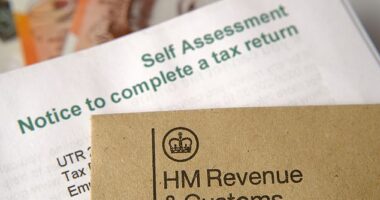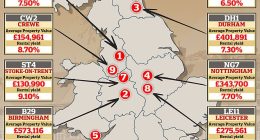FINISHING her end of month accounts Vicky Quait, 55, checks her in-comings against the outgoings.
It’s almost midnight and the self-employed nail technician is hit with a familiar sense of dread and fear when she checks her totals.
Vicky, who works from home in Radlett, Herts, has just enough money to cover her bills, buy groceries, pay her mortgage and buy supplies for her work each month with only £100 left in the kitty.
“Five years ago, I would have felt hopeful. Now heading towards my sixties I’m terrified. I feel like a failure because I don’t make enough each month to fund a private pension,” she says.
A private pension is different to the state pension, which is built up via paying National Insurance contributions (NICs) throughout working life.
It can be accessed from the age of 66 (due to rise to 67 by 2028 and 68 by 2046) and is currently worth £11,501 a year.
Read more on retirement
Most employees now pay into a private pension automatically through their workplace under rules first introduced in 2012, unless they opt out.
But those who work for themselves are not.
“I wake up at 3am hit with panic about it. I thought going self-employed would mean I would make more money,” Vicky tells Sun Money in this exclusive interview.
“All I wanted was to be able to fund a simple retirement. Now a basic private pension is out of my reach. I cannot afford to retire.”
Most read in Money
“I am terrified I have left it too late. I spent thousands of hours searching for simple private pension plan advice. I end up confused and anxiety ridden.
“It’s so bad I will have to crack open an old pension from my twenties next year just to pay bills. I am not alone in this,” she says.
People can build up several private pensions if they’ve had different jobs over the years, and these can be accessed from the age of 55 (soon to rise to 57 from 2028).
“I just want a simple self-employed private plan where I can pay a tenner or more per week. What’s the point of working for myself if I don’t have that.”
According to single Vicky, she did a five-year plan in 2017 for her self-employed nail technician work.
“The plan predicted by earnings would have been enough by 2023 to fund up to £250 a month for a private pension,” she says.
“The money would have been savings to gateway into a pension. That hasn’t happened because the cost of living hikes were greater than anyone predicted.”
“Instead that £250 has been eaten up on cost-of-living price hikes, rising gas and electric prices and increase in council tax and fuel costs, and affected by downturns caused after Covid.
“Whenever I try to find a private pension plan for my self-employed needs, I am told I’ll pay thousands in consultants or set up costs.
“If I try to search for myself my head ends up spinning. I’ve tried to understand the difference between stakeholder pensions and a SIPP [self-invested personal pension] plan.
“Then getting reliable information about which plan to choose and what my projected returns are on even fifty quid a month ends up becoming a blurry mess of numbers and options.”
I think I’m a failure
Vicky Quait
Vicky says that self-employed grafters like her are discovering saving for retirement is now unaffordable.
“Private pension plans are for PAYE [pay-as-you-earn] staffers and people with bigger businesses.
“It’s shocking that someone like me who works up to sixty hours a week in their mid-fifties cannot afford to put money aside.
“Self-employed people simply don’t have the protection and benefits of PAYE staffers.
“The government encourages self-employed work but doesn’t help us consider the impact of people like me not having a private pension,” she says.
Hardworking Vicky is just one of the 4.33million self-employed workers currently earning a living in Britain in 2024 who may now be panicking about their retirement savings.
According to Census 2021 data, just 20% of self-employed people were paying into a pension between April 2018 and March 2020, compared with 80% of employees.
That means a staggering 3.4million self-employed people in Britain are without a private pension at all, meaning they are relying on state pension or an upturn in the economy to bolster their retirement coffers.
“I am in a mid-life crisis caused by pension stress,” says Vicky.
“I wish I could afford a sports car like many people buy in their crisis year. I can’t afford bus fare and I work for myself. Something is terribly wrong.”
It comes as the Association of Independent Professionals and the Self-Employed reveals around 67% – or two in every three – self-employed people are “seriously concerned” about their retirement savings – equivalent to more than 2.9million people.
According to the Department for Work and Pension, 53% of people without a private pension say they cannot afford to make contributions.
Because of this, more Baby Boomers are retiring later or returning to work because their pension plans and retirement funds have been crippled by the cost of living crisis, figures show.
A 2021 report by Retirement Villages Group revealed 900,000 Brits aged over 70 are heading back to work or staying longer in part- or full-time work since the pandemic and cost of living crisis began.
Vicky’s situation becomes even more concerning because of the gender pensions gap.
What are the different types of pensions?
WE round-up the main types of pension and how they differ:
- Personal pension or self-invested personal pension (SIPP) – This is probably the most flexible type of pension as you can choose your own provider and how much you invest.
- Workplace pension – The Government has made it compulsory for employers to automatically enrol you in your workplace pension unless you opt out.
These so-called defined contribution (DC) pensions are usually chosen by your employer and you won’t be able to change it. Minimum contributions are 8%, with employees paying 5% (1% in tax relief) and employers contributing 3%. - Final salary pension – This is also a workplace pension but here, what you get in retirement is decided based on your salary, and you’ll be paid a set amount each year upon retiring. It’s often referred to as a gold-plated pension or a defined benefit (DB) pension. But they’re not typically offered by employers anymore.
- New state pension – This is what the state pays to those who reach state pension age after April 6 2016. The maximum payout is £203.85 a week and you’ll need 35 years of National Insurance contributions to get this. You also need at least ten years’ worth to qualify for anything at all.
- Basic state pension – If you reach the state pension age on or before April 2016, you’ll get the basic state pension. The full amount is £156.20 per week and you’ll need 30 years of National Insurance contributions to get this. If you have the basic state pension you may also get a top-up from what’s known as the additional or second state pension. Those who have built up National Insurance contributions under both the basic and new state pensions will get a combination of both schemes.
It shows at the of age 55, all women experience a 35% gap in retirement savings compared to men.
The difference has been put down to a gap between what men and women earn, as well as women being more likely to take time off work, or work part-time, for caring responsibilities.
A third (34%) of women claim they don’t have a private pension plan, compared to 17% of men.
It’s backed up with studies by online investment service provider Willis Owen, revealing of women without a pension, 41% had no intention of starting one or couldn’t afford to.
It’s heart-breaking I don’t have money left over to save
Vicky Quait
The research found that 17% of women don’t intend to start a pension until they are at least 40, and nearly one in ten don’t anticipate starting to pay into one until they are 50.
“When I read this research, I knew I wasn’t alone. Self-employed women my age don’t talk about private pension stress. We think we are all alone. I am just one of millions. It’s why we need help,” she says.
Vicky earns up to £1,200 a month from her nail art business and has between twenty to forty clients a week.
“Lockdown hit my business hard. Now I do mobile nails and see people at my home studio. It means long hours. I am not afraid to work even more hours,” she says.
“It’s heartbreaking I don’t have money left over to save for retirement.
“Self-employed people are living hand to mouth. We can’t afford to think about the future let alone plan for it.”
Vicky’s monthly earnings cover mortgage, energy and food costs, but says there is seldom anything left after bills, and is often overdrawn.
Like many self-employed people, Vicky relies on credit cards or loans.
“I owe around £4k on cards. I need the cards because they function as a buffer to the down times.”
Vicky pays £258 a month on her mortgage and her two-bed house is currently worth around £440,000.
How does the state pension work?
AT the moment the current state pension is paid to both men and women from age 66 – but it’s due to rise to 67 by 2028 and 68 by 2046.
The state pension is a recurring payment from the government most Brits start getting when they reach State Pension age.
But not everyone gets the same amount, and you are awarded depending on your National Insurance record.
For most pensioners, it forms only part of their retirement income, as they could have other pots from a workplace pension, earning and savings.
The new state pension is based on people’s National Insurance records.
Workers must have 35 qualifying years of National Insurance to get the maximum amount of the new state pension.
You earn National Insurance qualifying years through work, or by getting credits, for instance when you are looking after children and claiming child benefit.
If you have gaps, you can top up your record by paying in voluntary National Insurance contributions.
To get the old, full basic state pension, you will need 30 years of contributions or credits.
You will need at least 10 years on your NI record to get any state pension.
“I have an old workplace pension from when I used to work as a personal assistant in finance two decades ago. There’s £23,000 sitting in it,” she says.
“I don’t know what fund to put it into so I can maximise returns. I have terrible anxiety because I have convinced myself I will get ripped off or get bad advice.”
Vicky says she is now planning on accessing it in the next two years just to pay bills and help her handle the cost of living hikes.
“I hadn’t planned to do that but I don’t know what else to do. I am 55 years old. I have dedicated the last ten years to my nail business. I can’t start a new career in middle age, and I have to continue working. It’s why I graft so hard.”
She is considering downsizing from a house to a flat and in her sixties she can still work – but fears she may end up with no home at all and relying solely on the state pension.
READ MORE SUN STORIES
“I think I am a failure. I should be planning amazing holidays and cruises for my retirement.
“In your late forties and even early fifties retirement seems a long way off. Now I know I will be working into my eighties because I decided to go self-employed.”








